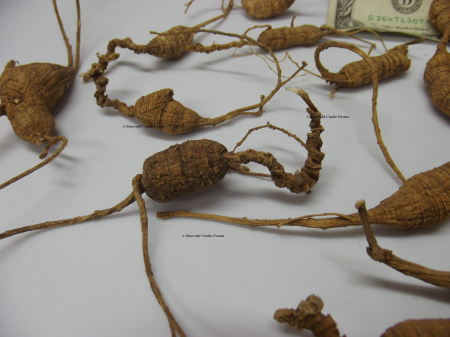Good Ginseng?
June 10, 2015
Over the years one of the most common things diggers tell me when they approach the scales is "Boy this is some good ginseng!" I've always tried to inform and educate my diggers as to what is desirable for the current market. However, some folks are more graceful than others when it comes to receiving this advice. Even on a dealer level, I must admit sometimes it seems like we are trying to hit a moving target when putting together lots of ginseng for a buyer.
So, what characteristics makes good ginseng? And, more commonly, what mistakes makes good ginseng not so good and how can we avoid making them. Before we get into it, let me give my standard advice. First, dig carefully. You do not know what is under the ground, in which direction, or how far those ginseng roots travel. You must start loosening the ground well away from the ginseng plant stem. I think this is the reason that people who dig with screwdrivers cause more damage than I see caused by any other tool. They are trying to dig the root out, not loosen the ground around the root so they can lift the root out carefully and intact. I recommend the standard trapper's trowel, but small shovels and mattocks work well for folks who are careful with them. Next, clean the root carefully. I recommend just tossing them into a container of water and letting them soak for a few minutes. After the dirt is loosened, just swish the roots around one at a time until all of the loose dirt has washed off. Gently use your finger to rub off stubborn clumps of dirt or clay. Never use a brush or stream of water to wash ginseng. The desired result is to leave the dirt in the rings to accentuate them. Brushing can also damage the skin as we will see in the pictures.
Next comes drying. Never dry ginseng in the sun or a vehicle. Let it air dry. Heat between 80 and 95 degrees is advantageous as long as it is consistent and there is adequate air flow. Never let the temperature get over 100 degrees as this can caramelize the sugars in the root and result in a very low quality root. I most commonly use racks made of furring strips. I make frames to slide inside the rack and cover the bottom of the frames with nylon screen material. I set a small fan under the racks in such a way that it will blow air up through the racks. When it starts to get cooler at night, I cover the whole rack with a canvas tarp and add a small thermostatically controlled heater beside the fan -and a thermometer to check the temperature. Cardboard can be substituted for the screen, but the air flow will have to be configured in such a manner that it blows over all the racks from the side.
If you have done a good job selecting high quality marketable plants to dig and handled them professionally, you will hopefully wind up with some ideal ginseng to take to your dealer. Unfortunately, not all ginseng is created equal, and some areas of the country (even the state) have better ginseng on average than do other areas.
Here are the basic rules in their most common order of importance.
- Corkey (less dense like cork) rather than boney (more heavy and dense).
- Good wild character rather than smooth and carrot-like.
- Shorter and stubbier rather than long and thin.
- Older rather than younger.
- Larger rather than smaller.
- And finally, darker skin rather than lighter skin.
No one wants boney root. No matter how wild it looks or how big and old it is, if it is boney it will be worth no more than about 1/3 of the going market price at best. The other qualities can be shifted around a little. For instance, if you have older, bulby (short and stubby) root but it is relatively young but has good wild character, it might it might be worth more than older root with a less desirable shape.
Let's take a look at a couple lots of generally pretty good ginseng. Both are high quality overall.
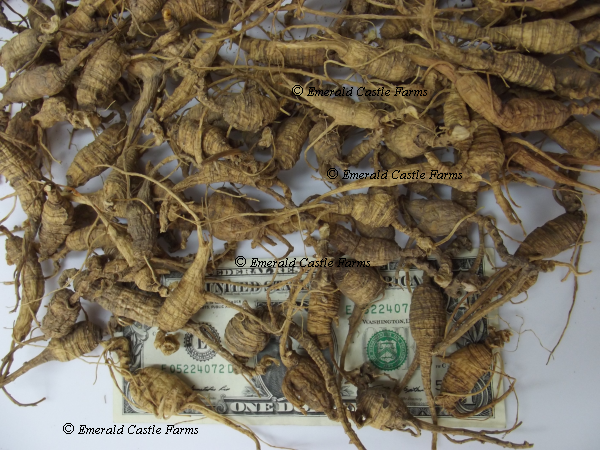
Good quality, excellent wild character, but a little small.
Lot 1: This lot has a few less than desirable roots and the size is generally smaller than ideal. However, I would pay top dollar for this lot because even with a few pick-outs, it is a very good high quality collection overall. There are some very nice roots in this lot with excellent wild character.
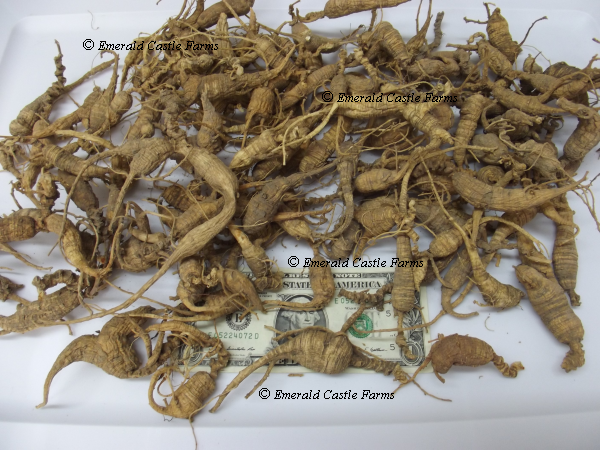
Good quality overall, a few problems though.
Lot 2: This lot is larger than Lot 1, but slightly lower in quality. There are some less desirables here (red-root, washed a little too clean, and poor shape), however, I would give top dollar for this lot after removing the worst problem roots. The larger size makes up for the less than stellar wild character of a few of the roots, but the larger the roots are, the more the dealer stands to lose when his/her buyer picks out some less desirable roots.
I know that many folks reading this won't see the problems with that second lot. So, let's look specifically at issues with ginseng quality. Sometimes when you select out roots with common issues and look at them all together, it makes seeing the problem simpler.
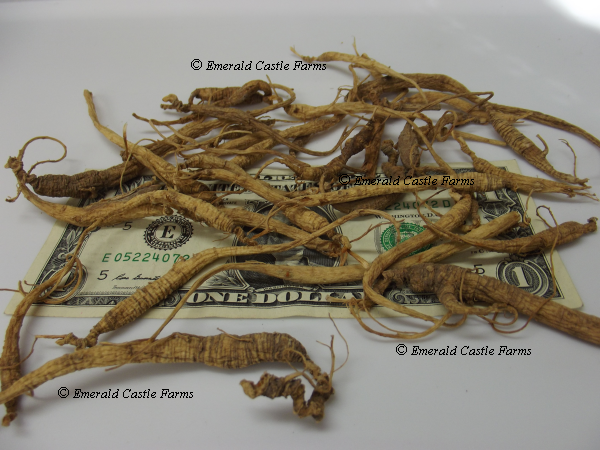
Leave the pencils in the woods to make seed.
This was a common problem during the 2014 season. Some call them pencils others chicken bones, but by any name -don't dig ginseng that looks like this. I can't tell you how many times I've question guys on the small roots they bring me and they act offended saying they only dig three-prong or larger plants. Yet, I transplant those very roots and guess what -they show up as small two-prong plants every time. Many of these roots in the picture are very young still. Some have no wild character at all, and others are older and have good wild character, but are just such a poor shape they will bring any lot down if not sorted out. Some areas tend to grow more long thin roots than do other areas. The only thing you can do is let them grow longer. Always check the general quality and size of the roots before you completely dig it. You can see how long the neck is, what general shape the root is and if it is as big as your thumb before completely unearthing it. And guess what? If you get surprised and wind up with a low quality root -you can always plant it right back. They are worth much more in the woods making seeds than they are on the dealer's table.
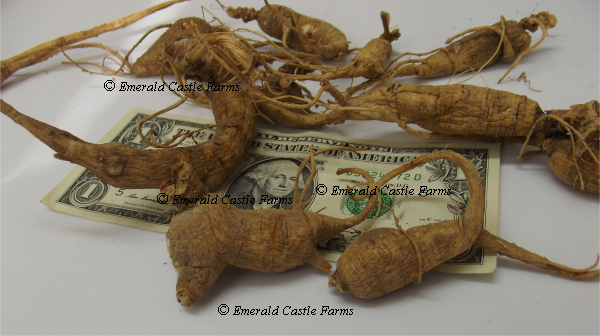
Boney ginseng is undesirable and at best worth about 1/3 of the going market price.
Boney ginseng is not desirable -period. At most, boney ginseng is worth only about one third of the going market price, and will always be pick-out regardless of size or age. In this picture you can see some boney root. Notice the scaly appearance as opposed to the heavily ringed appearance we see in higher quality ginseng? If you pick up a ginseng root and it feels as if it is exceptionally light and airy, it is said to be corky (think cork or balsa wood). On the other end of the spectrum is boney. Boney root is heavy and dense like bone or rock. You can often feel the difference in a boney and corky root of the same approximate size by comparing them together. Another way to identify boney root is to drop the root about an inch onto a table. If the sound is sharp like a small stone, it is boney. However, if the sound is light and dull -maybe thud-like- it is corky. Corky root is always desirable and adds greatly to the overall quality of a given lot.
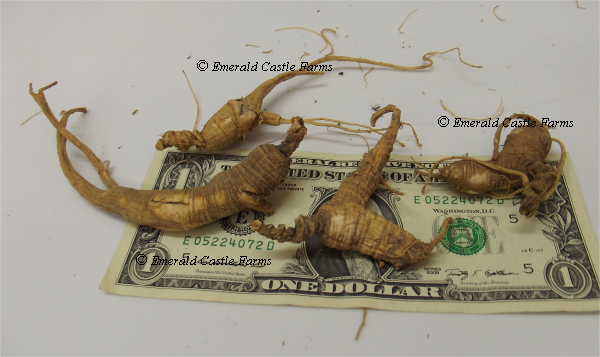
Damage happens, but most of the time can be avoided.
Like boney root, damaged root is only worth about a third going market price. I know that sometimes you hit a root. It happens. However, being more careful, taking your time and using the digging tool to only loosen dirt well away from where you think the root is and using your hands to uncover the root itself will help tremendously. I see more damage to roots by screw drivers than any other digging tool out there. Also in this picture we see another common problem. Damaged skin. Would you buy an apple with a chunk of skin rubbed off? Normally this is caused by over washing. Never use a brush on ginseng. We want the dirt to stay in the rings and we want to only remove the excess dirt down to the skin. Just soak the roots for a few minutes and rub off loose dirt with your finger. Root that is unwashed is as bad as root that is too clean. Either of these conditions will significantly downgrade the quality and price of your ginseng.
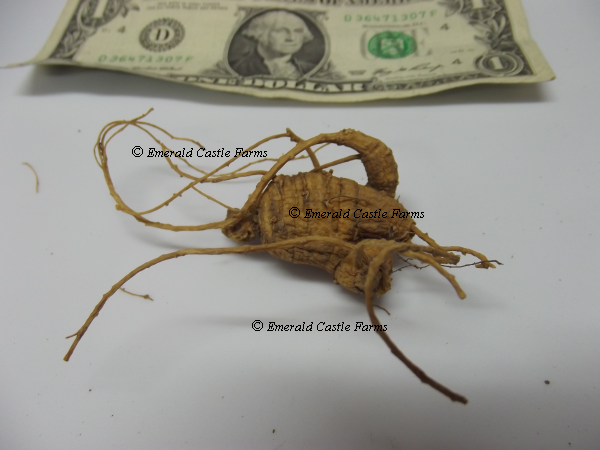
Transplants become pick-out if noticed.
The root in the picture is bulby and has good color and size. However, that is all that it has going for it. This root would be thrown out of every lot if it is noticed. Why? Two reasons. First, notice that this is a transplanted root. We have all moved ginseng around from time to time. This is the reason we have to be careful and make sure the roots are laid out correctly. This root appears to have been placed into a small hole with the smaller roots turned up. This creates a fishhook appearance commonly found in transplanted roots.
Another issue this root has is the high amount of small roots. This particular root isn't as bad as some, but commonly after transplanting feeder roots sprout out and woodsgrown or transplanted roots often have twice the number as do truly wild (including properly grown wild simulated) roots do. The reason this is important is that all of those small roots are worth going market price while attached to the main root. However, once they break off, they become fiber (or fines). Fiber is only worth about $125/lb last I checked. That means if I buy roots with more fiber, I lose more money. Wild ginseng normally has about 7-8% fiber compared to about 14% for woodsgrown and transplanted roots. So, in a $700/lb market, transplant or woodsgrown roots mathematically result in a loss of $40 per pound more than wild because of fiber.
A third issue common with woodsgrown and transplanted roots for which I have no pictures at the moment is thick necks. Thick necks are a classic characteristic of cultivated and woodsgrown/transplanted ginseng. Any time it appears like you have tried to cheat the system and produce something less than natural, sooner or later it will cost you.
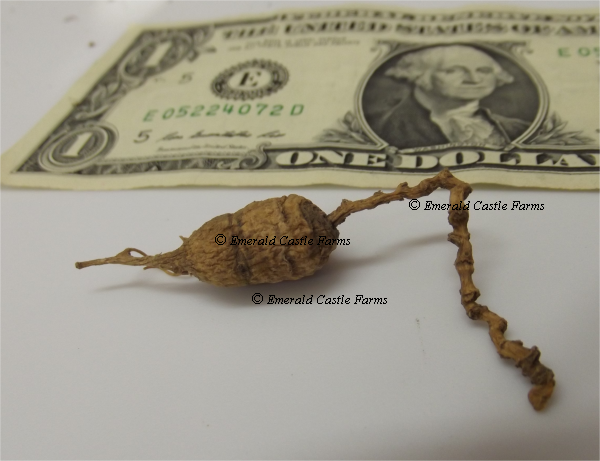
Wild ginseng normally has thin necks and a small size/age ratio.
Here is a picture of a nice small bulby root. Notice how petite the neck is. For a root that is over fifteen years (likely over 20 years), it isn't very big. So, when you bring a dealer a bucket full of ginseng that weigh about an ounce each, they have necks as thick as my thumb and are only six or seven years old -expect a reduced price.
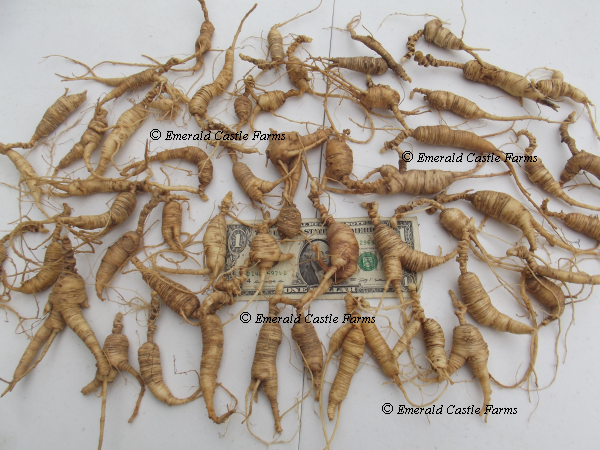
A nice top dollar lot of green ginseng.
Here is a picture of a nice collection of green root. Notice the excess dirt is washed off so the color of the skin can be easily observed. The lot is larger in size generally, and most of the roots possess desirable shape, wild character, and age.
Another important thing to consider is the fact that collections of ginseng need to look similarly. If we have a few roots with excessive fine roots, are scrubbed until they are nearly white, or are not washed at all and are just dirty, those will not 'fit' into a collection. Fit is something that causes roots which otherwise by themselves might look ok to be picked out of a lot. Some dealers deal in different quality roots. A dealer who deals in the higher quality market cannot afford to buy commercial quality root for the same price s/he buys higher quality roots. Commercial quality ginseng is commercial quality ginseng. No matter how old it is, or how big it is, or how much trouble you went through to find it -its natural character will never change.
So, it is up to us what we bring to market. If we want to see higher prices, we need to select the roots we chose to dig carefully, dig them with patience and care, handle them professionally, and get them to the dealer in good condition. I cringe when I see people walking up to the scale with a plastic bag full of ginseng bouncing off their leg as they walk. Get the plastic shoe boxes from the local department store. They cost about a dollar, the lids are not air tight, and you can stack them without damaging the ginseng on the bottom.
Always remember this word of advice that was given to me. Every root we dig either increases or decreases the value of our collection. If we take our obligation to conserve wild ginseng seriously, and bring only the highest, well handled collections to the market, we must selectively harvest. We just cannot dig every legal plant we see. This one change alone will ensure that you will always get top dollar for your ginseng.
~Brad